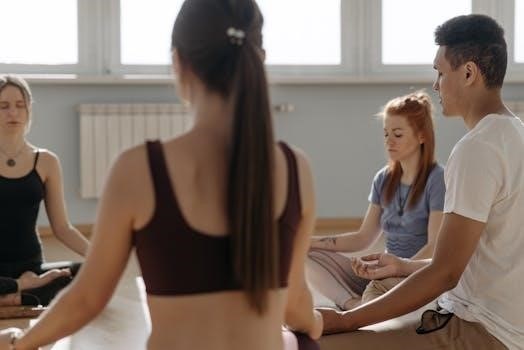
-
By:
- otis
- No comment
how to lead a guided meditation
Leading a guided meditation involves creating a safe, relaxing space. First, prepare yourself and the environment. Then, choose a script or theme that resonates. Speak clearly, slowly, and with intention, allowing pauses. Finally, be present and adapt to the group’s needs.
Understanding Guided Meditation

Guided meditation is a transformative practice that involves being led through a meditative experience by a facilitator. Unlike silent meditation, it offers structured instructions and narratives, making it accessible for beginners and experienced meditators alike. The facilitator uses spoken word to guide participants through visualizations, breathing exercises, and mindfulness techniques.
The core of guided meditation lies in its ability to promote relaxation, emotional regulation, and self-awareness. It helps reduce anxiety and manage stress by providing a focal point for the mind, preventing it from wandering into anxious or negative thought patterns. Through visualization, participants can create mental imagery that evokes positive emotions and a sense of calm.
Furthermore, guided meditation can enhance self-discovery by encouraging introspection and reflection. Scripts often explore themes of compassion, gratitude, and self-acceptance, guiding participants to connect with their inner selves. Ultimately, it’s a powerful tool for cultivating a deeper understanding of oneself and fostering a greater sense of well-being.

Benefits of Guided Meditation
Guided meditation offers a multitude of benefits, impacting both mental and physical well-being. One of the most significant advantages is stress reduction. By guiding the mind away from racing thoughts and worries, guided meditation promotes a state of deep relaxation. This, in turn, lowers cortisol levels, the hormone associated with stress, leading to a greater sense of calm and peace.
Improved sleep is another key benefit. Regular guided meditation can help quiet the mind before bed, making it easier to fall asleep and stay asleep throughout the night. The practice can also enhance emotional regulation, fostering greater self-awareness and the ability to manage challenging emotions effectively.
Beyond stress and sleep, guided meditation can boost overall well-being. It has been shown to improve focus, concentration, and even creativity. By cultivating a sense of mindfulness, individuals become more present in their daily lives, appreciating the small moments and experiencing greater joy. Moreover, it can foster self-compassion and acceptance, helping individuals to cultivate a kinder relationship with themselves.
Preparing to Lead a Guided Meditation
Before you embark on guiding others in meditation, thorough preparation is key. Begin by practicing the meditation yourself. Familiarize yourself with the script or theme, internalizing the rhythm and flow. This will allow you to guide with confidence and authenticity, instead of just reading words on a page.
Consider your audience and tailor the meditation accordingly. Are they beginners or experienced meditators? Adjust the language and complexity to suit their level. Choose a length that is appropriate for their attention spans and time constraints. Shorter meditations are often best for beginners, while more experienced practitioners may appreciate longer, more in-depth sessions.
Prepare the physical space. Ensure it is quiet, comfortable, and free from distractions. Dim the lights, offer comfortable seating or mats, and consider using aromatherapy or soft music to create a relaxing atmosphere. Finally, center yourself before beginning. Take a few deep breaths, quiet your mind, and connect with your intention for guiding the meditation. This will help you create a calm and focused presence for your participants.
Choosing a Theme or Focus
Selecting a theme or focus is crucial for a meaningful guided meditation. Consider the needs and intentions of your audience when making this choice. Common themes include stress reduction, self-compassion, gratitude, and connecting with nature. You might also focus on specific areas of the body or energy centers.
Think about what resonates with you personally. Your passion for the theme will translate into a more authentic and engaging experience for your participants. If you are drawn to nature, a visualization of a peaceful forest or beach could be a great option. If you are passionate about self-love, a meditation focused on self-acceptance and kindness might be a good fit.
Research and explore different themes to find one that aligns with your goals. Read scripts, listen to guided meditations, and experiment with different techniques. Once you have chosen a theme, delve deeper into it. Understand the underlying principles and benefits, and consider how you can best convey them to your audience. Finally, ensure the theme is accessible and inclusive for everyone in your group.
Writing Your Meditation Script
Crafting a meditation script requires careful consideration. Start with a clear intention for the meditation, aligning it with your chosen theme. Begin with an introduction that sets the tone, welcoming participants and explaining the purpose of the meditation. Use simple, evocative language that is easy to understand and visualize.
Structure your script with a logical flow, guiding participants through a series of steps. Begin with body awareness, encouraging them to notice sensations without judgment. Gradually introduce visualizations or imagery, painting a vivid picture in their minds. Incorporate affirmations or mantras to reinforce positive beliefs and intentions.
Remember to leave space for silence and reflection. Pauses allow participants to fully integrate the experience and connect with their inner selves. Keep the script concise and focused, avoiding unnecessary details or distractions. End with a gentle return to the present moment, expressing gratitude and encouraging participants to carry the peace and clarity they cultivated into their daily lives. Always review and refine your script for clarity, flow, and impact.
Structuring the Meditation
A well-structured meditation guides participants smoothly through the experience. Begin with an introductory phase, setting the intention and creating a welcoming atmosphere. Guide participants to find a comfortable posture, either seated or lying down, and encourage them to close their eyes gently.
Next, focus on breath awareness, inviting participants to notice the natural rhythm of their breath without trying to change it. This anchors them in the present moment and helps calm the mind. Gradually introduce body scan techniques, guiding participants to bring awareness to different parts of their body, noticing any sensations without judgment.
Transition into visualizations or guided imagery, using descriptive language to create a mental landscape that promotes relaxation and well-being. Incorporate affirmations or positive self-talk to reinforce desired qualities or intentions. Allow for periods of silence, giving participants time to integrate the experience and connect with their inner selves. Finally, guide participants back to the present moment with a gentle return, encouraging them to carry the sense of peace and clarity into their day. Maintain a consistent rhythm and pace throughout the meditation, allowing participants to fully immerse themselves in the experience.
Creating a Comfortable Environment
A comfortable environment is crucial for a successful guided meditation. Start by choosing a quiet space free from distractions. Ensure the room is at a comfortable temperature, not too hot or too cold. Soft lighting, such as dimmed lights or candles (if allowed and safe), can enhance the atmosphere. Offer comfortable seating options like cushions, blankets, or chairs, allowing participants to find a posture that supports relaxation.
Consider using aromatherapy with calming scents like lavender or chamomile, but be mindful of sensitivities and allergies. Play soft, ambient music or nature sounds at a low volume to create a soothing backdrop. Minimize external noises by closing windows or using a white noise machine. Before beginning, invite participants to adjust their clothing or position to maximize comfort.
Communicate that they are welcome to shift at any time during the meditation if needed. A comfortable environment allows participants to fully relax and immerse themselves in the meditation experience, maximizing its benefits. Ensure that the space feels safe, inviting, and conducive to inner peace.
Speaking Clearly and Slowly
Speaking clearly and slowly is essential for effective guided meditation. Your voice is the primary tool for guiding participants into a relaxed state. Enunciate each word carefully, ensuring that your instructions are easily understood. Maintain a calm and even tone, avoiding any abrupt changes in volume or pace. A slow speaking pace allows listeners time to process your words and visualize the imagery you’re creating.
Incorporate pauses strategically throughout the meditation. These pauses provide space for reflection and integration, allowing participants to fully experience each stage of the meditation. Avoid rushing through the script; instead, embrace the silence as a powerful element of the practice. Pay attention to your breathing, and let your breath guide the rhythm of your speech.
Imagine you are gently leading each person by the hand, guiding them deeper into relaxation. Practice your script beforehand to become comfortable with the pacing and phrasing. A clear, slow, and deliberate delivery creates a sense of safety and trust, allowing participants to surrender to the experience fully. Monitor your speech for filler words like “um” or “ah,” and consciously reduce their use.
Using Music and Sound
Incorporating music and sound can significantly enhance a guided meditation experience, deepening relaxation and fostering a sense of connection. Choose instrumental music with a slow tempo and gentle melodies. Nature sounds, such as rain, ocean waves, or birdsong, can also create a calming atmosphere. Ensure the music is subtle and doesn’t overpower your voice; it should complement, not distract.
Experiment with different types of sounds to find what resonates best with your theme and audience. Binaural beats and solfeggio frequencies are known for their potential to induce specific brainwave states, promoting relaxation and focus. Consider using singing bowls or chimes at the beginning and end of the meditation to signal transitions.
Introduce sounds gradually, allowing participants to acclimate to the auditory environment. Adjust the volume to a comfortable level, and be mindful of any sensitivities or preferences within the group. Silence can also be a powerful sound element, creating moments of stillness and introspection. Be prepared to adjust or remove the music if it becomes distracting or counterproductive for any participants. The goal is to create an immersive and supportive soundscape.
Dealing with Unexpected Situations
Unexpected situations can arise during guided meditation, requiring adaptability and a calm demeanor. Someone might start coughing, shifting restlessly, or even experience strong emotions. Acknowledge the situation without disrupting the flow. Offer gentle reassurance, suggesting they adjust their position or take a few deep breaths. Avoid drawing undue attention to the individual; maintain a sense of inclusivity.
If someone becomes visibly distressed, discreetly offer assistance after the meditation. Have a backup plan for technical difficulties, such as a music malfunction. Be prepared to lead without music or switch to a different meditation script. If you lose your train of thought, pause, take a breath, and gently guide yourself back on track.
Remember that your presence and calm energy are crucial. If external noises interrupt the meditation, acknowledge them briefly and gently redirect focus back to the breath or the meditation’s theme. Ultimately, your ability to stay grounded and respond compassionately will create a safe and supportive environment, even amidst unforeseen circumstances. Flexibility is key to navigating these moments effectively.
Practicing Self-Care
Leading guided meditations can be deeply rewarding, but it’s essential to prioritize self-care. Regularly practicing meditation yourself is fundamental; this allows you to lead from a place of authentic experience and maintain your own well-being. Set boundaries to prevent burnout. Schedule time for rest and rejuvenation, ensuring you have adequate time to recharge your energy.
Reflect on your experiences leading meditations. What went well? What could be improved? Use these reflections to refine your practice and identify areas where you might need additional support. Engage in activities that nourish your mind, body, and spirit. This could include spending time in nature, exercising, pursuing hobbies, or connecting with loved ones.
Seek feedback from trusted sources, but also trust your intuition. Recognize that you can’t pour from an empty cup. Prioritizing your well-being enables you to show up more fully for others, creating a more impactful and sustainable practice as a meditation guide. Remember, self-care isn’t selfish; it’s essential for long-term effectiveness and personal fulfillment.
Example Meditation Scripts
Having a collection of example meditation scripts is invaluable for any aspiring or experienced guide. These scripts serve as templates, providing inspiration for various themes and styles. One common script involves a body scan, guiding participants to focus on different parts of their body, noticing sensations without judgment. This promotes relaxation and body awareness.
Another popular script centers on breath awareness, encouraging participants to observe their breath as it enters and exits their body. This cultivates mindfulness and grounds them in the present moment. Visualization scripts can transport participants to serene landscapes or guide them through positive affirmations, fostering a sense of peace and well-being. Consider scripts focused on compassion, guiding participants to extend kindness towards themselves and others.

Remember, these scripts are merely starting points. Feel free to adapt them to suit your unique style and the specific needs of your audience. Experiment with different word choices, imagery, and pacing to create a truly personalized and impactful meditation experience. Most importantly, practice each script yourself to ensure it resonates with you authentically.
